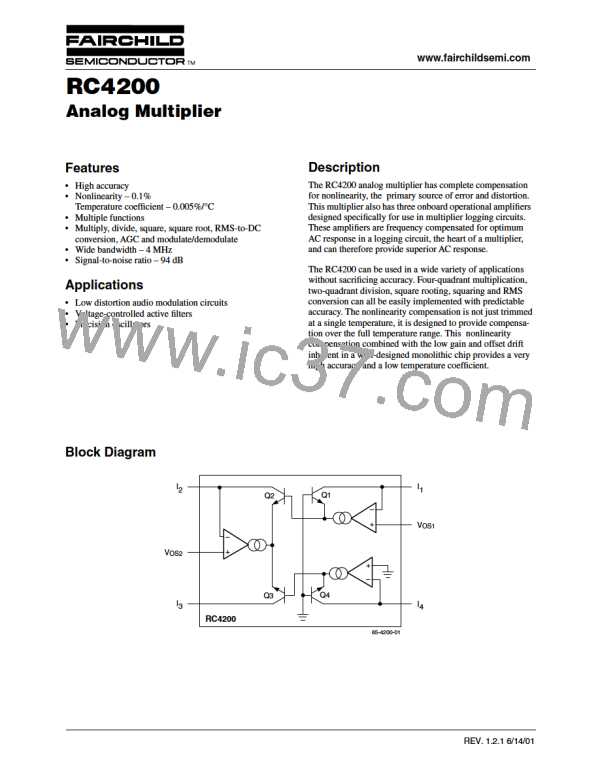RC4200
PRODUCT SPECIFICATION
Select R to be 1% or 2% below (or above) the calculated
d
value. This will cause α and β to both be positive (or nega-
tive) by nearly the same amount. Now the effective value of
Reducing Mismatch Errors
You need not use 0.01% resistors to reduce resistor product
mismatch errors. Here are a couple of ways to obtain
maximum accuracy out of the extended range multiplier
(see Figure 4) using 1% resistors.
R can be trimmed with an offset adjustment Z (R ) on
d
OS 20
pin 5.
This technique causes: a slight gain error which can be com-
pensated with the R value, and an output of offset error that
Method 1
0
V
X
feedthrough, for example, occurs when V = 0 and
Y
can be trimmed with V (R ) on the output op amp.
OS 16
V
≠ 0. This V feedthrough will equal V V .
X OSY
OSY
X
Also, if V
≠ 0, there is a V feedthrough equal to
OSZ
X
Extended Range Divider
The only cross-product error of interest is the V
Z
V V
. A resistor-product error of α will cause a V
X OSZ
feedthrough of αV . Likewise, V feedthrough errors are:
X
X
Y
V V
Y OSX
, V V
and βV
feedthrough (V = 0 and V ≠ 0) which is easily adjusted
Y OSZ
Y
X
OSX
with X (R ). See Figure 6.
OS
5
Total feedthrough:
V V V V
αV βV (V + V ) V
OSZ
Resistor product mismatch will cause scaling errors (gain)
that could be a problem for very low values of V . Adjust-
X OSY Y OSX
X
Y
X
Y
Z
By carefully abusing X (R ), Y (R ) and Z (R ) this
OS OS OS 20
equation can be made to very nearly equal zero and the
feedthrough error will practically disappear.
5
9
ments to Y (R ) can be made to improve the high gain
OS 18
accuracy.
Square Root and Squaring
These circuits are functions of single variables so
feedthrough, as such, is not a consideration. Cross product
errors will effect incremental accuracy that can be corrected
A residual of set will probably remain which can be trimmed
outwith V (R ) at the output of amp.
OS 16
Method 2
Y (R ) or Z (R ). See Figure 9 and Figure 11.
OS 14 OS 10
Notice that the ratios of R R :R R and R R :R R are
1 b CX d 2 a CY d
both dependent of R also that R , R , R and R are all
d
1
2
a
b
functions of the maximum input requirements. By designing
a multiplier for the same input ranges on both V and V
X
Y
then R = R , R
= R and R = R . (Note: it is accept-
1
2
CX
CY
a
b
able to design a four quadrant multiplier and use only two
quadrants of it.)
14
REV. 1.2.1 6/14/01

 FAIRCHILD [ FAIRCHILD SEMICONDUCTOR ]
FAIRCHILD [ FAIRCHILD SEMICONDUCTOR ]